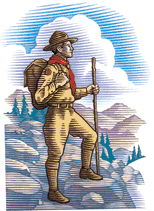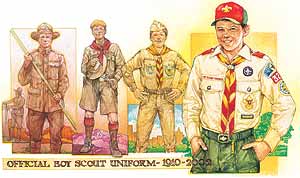![]() October 2002
October 2002


From Doughboy Duds to Oscar de la Renta
By Robert Peterson
Illustration by Joel Snyder
Over nine decades, the basic Boy Scout uniform has changed with (and reflected) the times.
 Robert S. S. Baden-Powell, the British founder of Scouting, spent most of his adult life in the uniforms of the British Army and the South African Constabulary, so it is not surprising that he recommended a uniform for Boy Scouts. He suggested that Scouts should look a lot like South African constables, with a broad-brimmed khaki hat, a neckerchief, a shirt with sleeves rolled up most of the time, shorts, stockings held up by garters, and comfortable shoes.
Robert S. S. Baden-Powell, the British founder of Scouting, spent most of his adult life in the uniforms of the British Army and the South African Constabulary, so it is not surprising that he recommended a uniform for Boy Scouts. He suggested that Scouts should look a lot like South African constables, with a broad-brimmed khaki hat, a neckerchief, a shirt with sleeves rolled up most of the time, shorts, stockings held up by garters, and comfortable shoes.
Baden-Powell wrote: "The correct wearing of the uniform and smartness of turnout of the individual Scout makes him a credit to our Movement. It shows his pride in himself and in his Troop."
Shorts not considered 'manly'
B-P's recommended outfit was endorsed by the infant Boy Scouts of America in 1910. The uniform appeared in the Official Handbook, the manual hastily patched together during the summer by Ernest Thompson Seton, the first Chief Scout, and published just six months after the BSA was born on Feb. 8.
Despite that endorsement, the Baden-Powell uniform design did not become popular with the first American Scouts. For one thing, they didn't like the idea of wearing shorts past the age of 5 or 6. Shorts were not considered manly, and most young teenagers wore knickers over their long underwear.
The job of choosing an acceptable uniform was given to a Committee on Badges, Awards, and Equipment appointed by the National Executive Board. That committee spent most of its time on merit badge requirements; uniforms were not mentioned in its minutes for 1910 through 1912.
But the first Boy Scout handbook, titled Handbook for Boys and published in August 1911, and the first Supply Department catalog both showed a uniform that looked like a miniature version of a U.S. Army uniform. It called for a khaki campaign hat; a five-button, choke-collar coat; knee breeches; and canvas leggings. The whole outfit cost $4.05.
Adult Scout "officers" could get a Norfolk jacket (a belted jacket with box pleats in front and back); trousers, or knickerbockers with leather leggings, for $5.
Too much like the Army?
Early histories of the BSA suggest that the military-style uniform was the work of the badges-and-awards committee. But the prime mover was probably Sigmund Eisner, of Red Bank, N.J., whose company manufactured uniforms for several of the world's armies and who became the BSA's official uniform and equipment supplier.
The Scout uniform was so similar to the U.S. Army's that during the mobilization for World War I, special steps were taken to distinguish it from its counterpart worn by "doughboys," as U.S. soldiers were called. On the front of their campaign hats, Scouts wore a metal badge of rank and Scouters wore one indicating their leadership position.
Early Boy Scouts remembered the uniform as a big attraction for them, although some parents had misgivings about it. One former Scout, Louis Hornbeck, recalled joining Troop 23 in Brooklyn, N.Y., over his parents' misgivings that Scouting might lead to soldiering.
"Many people came here from Europe because the male member of the family was threatened with military service," Hornbeck explained. "I suspect that was true of my father, who came here from Denmark. He didn't absolutely discourage me from joining the Scouts, but there was a concern."
Critics believed the concern was not entirely unfounded, because Baden-Powell was, after all, a military man. But Scouting's founder went to some lengths to dispel the notion that his program amounted to military training, and his writings on the movement as "peace Scouting" were reprinted in pamphlets issued by the Boy Scouts of America.
In 1915, while war continued to rage in Europe, some critics even accused the BSA of being anti-military. But the National Executive Board defended its neutral position: "The Boy Scout Movement neither promotes nor discourages military training, its one concern being the development of character and personal efficiency of adolescent boys."
Neckerchief, knee socks, shorts
The neckerchief, one of the features of Baden-Powell's suggested uniform, made its first appearance in the Supply Division catalog in 1917. Then, around 1920, during an overhaul of the Scout uniform, the neckerchief became standard dress. The high-collared five button coat was gone. In its place was either a khaki shirt with neckerchief or a four-button coat with rolled collar and open neck.
Scouts still wore campaign hats and breeches, but knee socks had replaced the original canvas leggings.
Shorts became more accepted after a Bermuda-length uniform version was mandated for official wear at the first national meeting of Scout executives in 1920. Chief Scout Executive James E. West wrote later that the shorts "caused merriment as well as interest."
For the next two decades, Scouts learned that shorts were comfortable camp wear. However, many continued to wear breeches on the way to and from camp.
During World War II, breeches began giving way to long trousers. Overseas caps, similar to those worn by GIs, came into fashion, despite the fact that they offered no protection from the sun and rain.
Enter Oscar de la Renta
The most complete overhaul of the Boy Scout uniform in nearly 60 years occurred in 1980. Fashion designer Oscar de la Renta donated his services for a two-year project of remaking all uniforms, for Boy Scouts, Cub Scouts, Explorers, and both men and women adult Scouters.
Gone were most vestiges of military flavor. Boy Scouts wore khaki (tan) short- or long-sleeved shirts with red-ribboned epaulets (to designate the Boy Scouting program). Shorts and trousers were olive (green) and had voluminous utility pockets.
Whether to include a neckerchief was a decision left up to each troop. Troops could also choose to wear either the new baseball-style cap, a red beret (introduced in 1972), or the classic "Smokey Bear" campaign hat.
The new design—which continues to be the official Scout uniform—was a far cry from the doughboy duds of the BSA's beginnings.
Contributing Editor Robert Peterson is the author of The Boy Scouts: An American Adventure. Read more about the history of the Scout uniform in two previous The Way It Was columns: "The Uniform," by Kenneth Wells (November-December 1988), and "A Brief History of Scout Shorts," by Keith Monroe (March-April 1995).
Copyright © 2002 by the Boy Scouts of America. All rights thereunder reserved; anything appearing in Scouting magazine or on its Web site may not be reprinted either wholly or in part without written permission. Because of freedom given authors, opinions may not reflect official concurrence.
| The Boy Scouts of America | http://www.scouting.org |